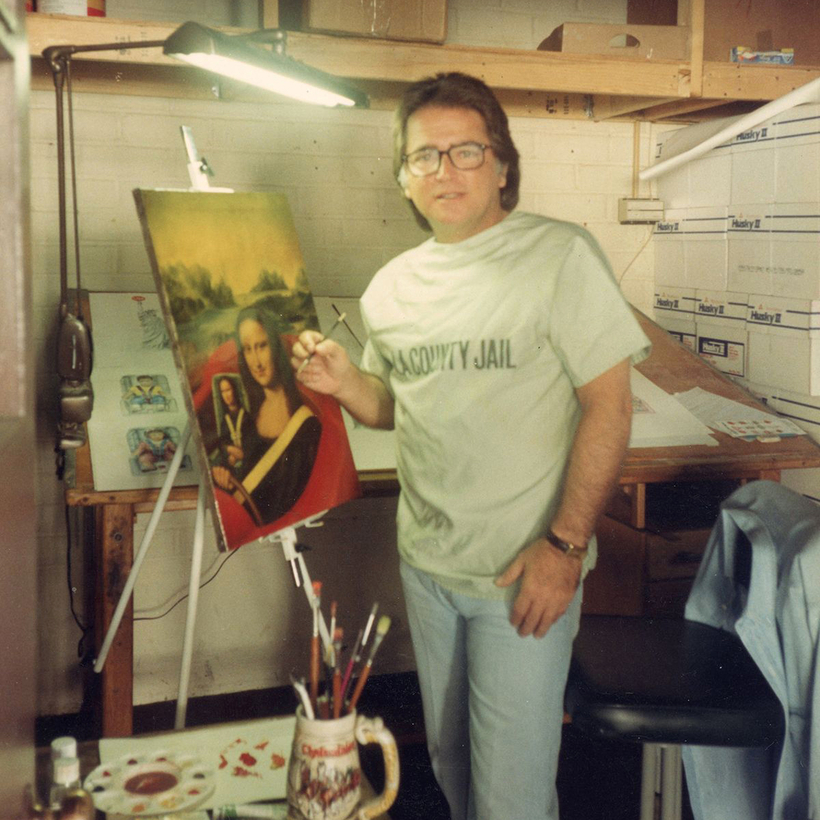Tony Tetro, the world’s greatest living art forger, knows of “at least two” major works in national collections that are fakes. His fakes, specifically, so we can probably take his word for it. But Tetro won’t say which ones. “That would open up a can of worms,” he tells me. “I’d be incredibly foolish.”
In fairness, the last time a counterfeit work by Tetro was discovered, things got very wormy very quickly. That was in 2019, when a collection of 17 blue-chip artworks were loaned to Dumfries House—a grand Scottish stately home beloved by King Charles III, who had it restored at a personal cost of some $91 million back in 2007.
The works had come to the royal via a certain James Stunt, 41, the now bankrupt gold baron who’d been one half of an outlandishly expensive divorce when he split up with Petra Ecclestone, the daughter of Formula One titan Bernie Ecclestone, in 2017. (Before this fall from grace, Stunt—whose godfather is an alleged crime lord and convicted money-launderer—had lived a life of staggering excess in and around London. For example, Stunt once claimed to have 200 supercars in his collection and infamously dropped $325,000 on champagne in a single evening at Tramp nightclub.)

The ploy was suitably brazen. Stunt allegedly commissioned Tetro—who can imperceptibly mimic everyone from Rembrandt to Caravaggio, Chagall to Dalí—to paint him a Monet. This, the forger assumed, would be used for bragging rights; another bauble to sit next to the golden Lamborghini. But instead Stunt used the fake piece—along with at least three others—as part of a flashy loan to the then Prince of Wales, who gushed over their quality and was delighted to show them off on the walls of his favorite royal house.
What’s more, the value of the collection soared as a result, meaning Stunt was able to use it as collateral on a series of gigantic loans to fund his lavish post-divorce lifestyle. But by 2019 the game was up, and the moody pieces, including Tetro’s “Monet,” were hurriedly removed. All the while, Stunt maintains that the pieces are authentic.

The palace might have done well to hold on to them. The value of a Tetro work, the artist tells me, has been steadily rising in the years since. “I did Triple Self Portrait, by Norman Rockwell, for someone recently,” Tetro says. “And he loves it.” But instead of claiming it’s an actual Rockwell, the buyer “now proudly tells people that it’s a real Tony Tetro!”
This is an aftereffect aided in no small part by a remarkable new memoir (Con/Artist, out now). And The Royal Stunt, an upcoming documentary about Tetro’s life (slated for release next year) from the Academy Award–nominated director Kief Davidson, and produced by Giampiero Ambrosi, the Los Angeles–based writer and investigative reporter who also collaborated on Tetro’s book.
Stunt used the fake piece—along with at least three others—as part of a flashy loan to the then Prince of Wales.
These days, the painter signs the back of every work with the word “FAKE” in indelible red ink—a condition of Tetro’s high-profile conviction back in 1993, following two decades as the most prolific forger of modern times. (“I’m the only person in the world who has to do that,” says Tetro proudly.)

It’s a wise precaution. Tetro is so good at what he does that his paintings pose something of a philosophical conundrum. If enough people believe a fake is real—if a Tetro work has been sold and authenticated as a Matisse 10 times over 30 years, say—does it, to all intents and purposes, cease to be a fake? This is the case for probably hundreds of pieces at large in the market right now, he says. (At one point in his memoir, Tetro recalls how he decided to take a liberty and subtly change the color on one part a fashionable Dalí print, Lincoln in Dalívision. “Now, mine are considered real, while the original color—Dalí’s—are considered fake,” Tetro writes.)
The Arches paper Tetro uses is always from the same era as the artists he is mimicking; his paints, likewise, are antique. Meanwhile, the collotype process he invented to reproduce his Chagall and Dalí lithographs—developed with two “printers from a previous era” in a “seedy part of town in Pomona”—are so accurate that Tetro briefly entertained the idea of forging banknotes too. It was only the thought of getting embroiled with the Mob that eventually put him off.

Besides, for most of his twentysomething-year romp, Tetro was pretty much printing money, anyway. Born in Fulton, New York (a rust-belt town that his father called “the asshole” of the state), Tetro moved to the West Coast in 1969 to make his name as an artist in his own right—but struggled to sell his Rembrandtesque works to a middle-class market that just wanted “something abstract to match their sofa,” he says.
“Then I discovered the book Fake! [about the 20th-century master forger Elmyr de Hory] and everything changed. I thought: I could do that.” By the end of the 1970s, Tetro was working in cahoots with a network of high-end dealers, each of whom had little black books full of wealthy clients who’d be delighted to get their hands on a miraculously discovered Modigliani, say. By the mid-1980s—“the era of ‘conspicuous consumption,’” says Tetro with a laugh—he owned a Ferrari, a Lamborghini, and a Rolls-Royce. Everyone in his neighborhood assumed he was a drug dealer.
But instead of claiming it’s an actual Rockwell, the buyer “now proudly tells people that it’s a real Tony Tetro!”
In 1988, however, it all came crashing down. One afternoon, the Japanese artist Hiro Yamagata was walking past a gallery in Beverly Hills with his family when he spotted one of his works in the window. Yamagata knew instantly that this piece wasn’t his, however—partly because he had an exclusive agreement with a gallerist just a block away. Furious, he ran inside and confronted the dealer, who confessed to buying the forgery and exposed Tetro in the process.
Soon, the Los Angeles District Attorney’s Office had embarked on an hours-long raid on the forger’s condominium (“Completed just two days earlier—they destroyed it!”), but strikingly failed to uncover Tetro’s secret room filled with his forging materials. During the trial, which took place “over four and a half years,” the D.A.’s Office was unable to find “a single person who came forward to say they were hurt financially or emotionally by my work in any way,” Tetro says. Nevertheless, he was convicted in 1993 and sentenced to a year in prison.

Today, reading Tetro’s electric memoir, the overwhelming sense is that his crimes belong to a bygone era—and perhaps a more innocent one, too. His style of forgery resides in an ancient, noble tradition as old as fine art itself. It is palatable and admirable, almost, because it requires such unique and wide-ranging skills—Caravaggio couldn’t be Rembrandt, but Tetro could be both. And because it seems to thumb its nose at the pomposity of the art market.
Nowadays, in an age of A.I. brushstroke detection and micro-spectrometry pigment analysis, it would be impossible for a forger such as Tetro to operate for long. But the fraud that has filled that hungry gap is more subtle and sinister, Tetro and his co-author, Giampiero Ambrosi, tell me. “The game now is that you get a painting by a student or a follower of Van Dyck that costs you 10K, then you get some crooked expert to call it a Van Dyck,” Ambrosi says. “They know they can’t fake it anymore, so they have to do something different.”
It’s all reminiscent of the case of the Salvator Mundi, perhaps—an average painting of truly controversial provenance that was hyped up by a series of vested experts and saucer-eyed dealers until it sold at Christie’s as “The Last da Vinci” for $450 million in 2017. That work is currently thought to reside on Mohammed bin Salman Al Saud’s super-yacht.
“You pump up its fame, and then stick it in some sort of financial transaction, where it simply becomes collateral for a loan or something else,” says Ambrosi. In the Dumfries House debacle, “Stunt just used the paintings as financial instruments in a game, which seems to me much more depressing,” he continues. “Forgery as I did it is a thing of the past,” says Tetro with a sigh. “That game is over.” So what would he be doing if he was a young, hungry artist striking out today? Ambrosi responds with a wry smile. “I think Tony would be big in NFTs.”
Joseph Bullmore is a Writer at Large for AIR MAIL and the editor of Gentleman’s Journal in London

